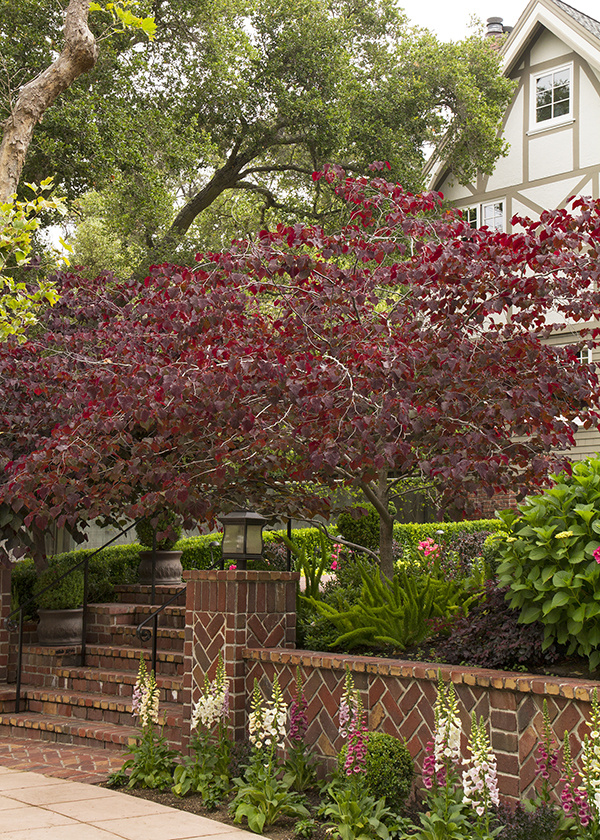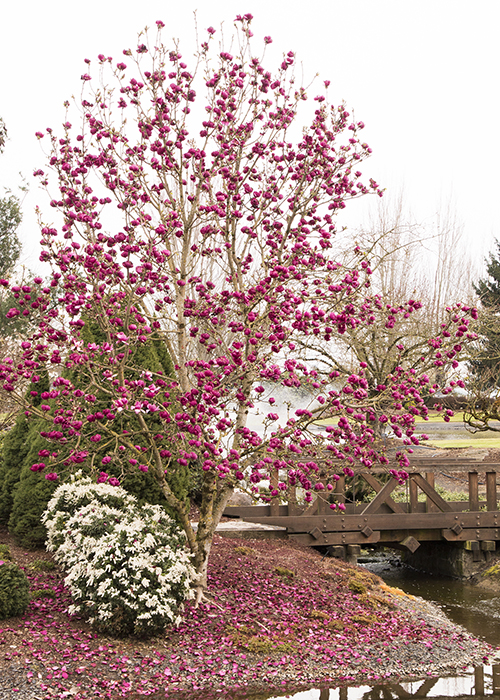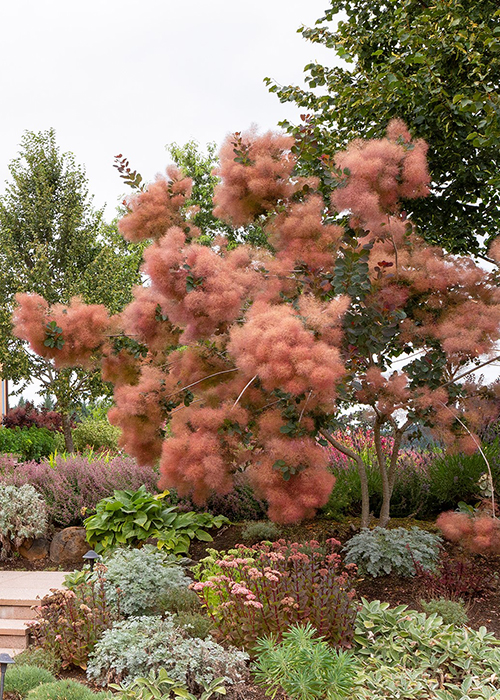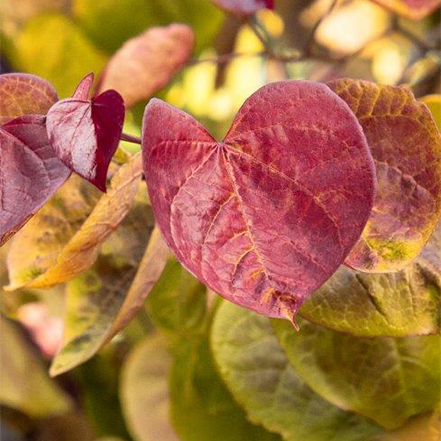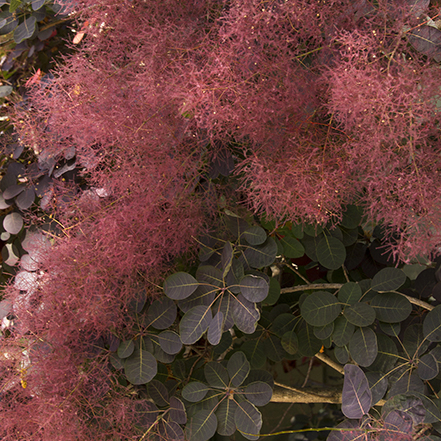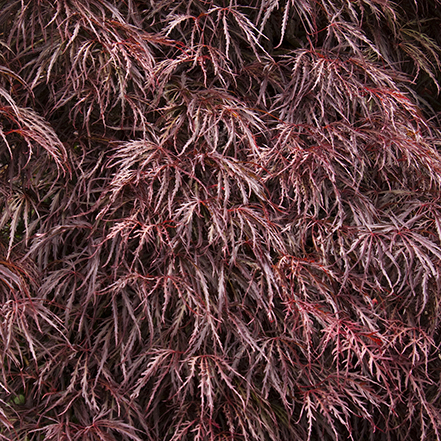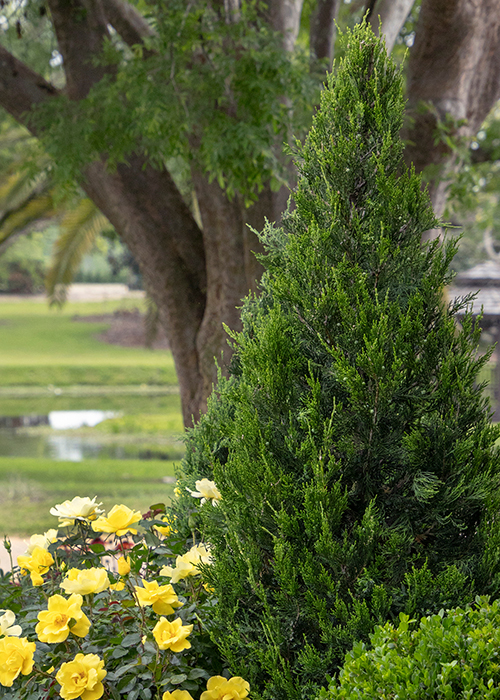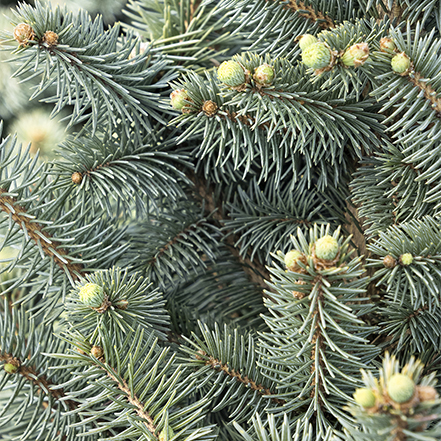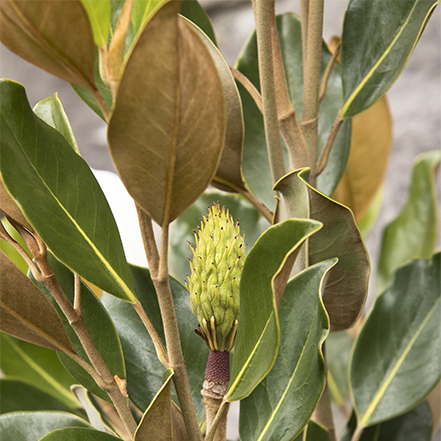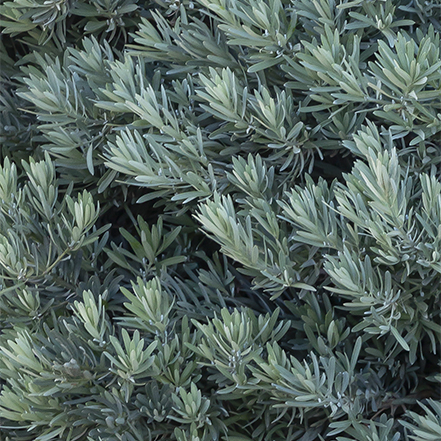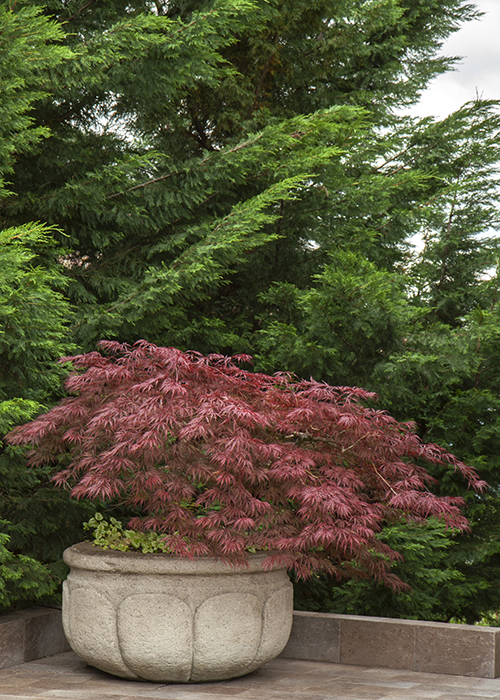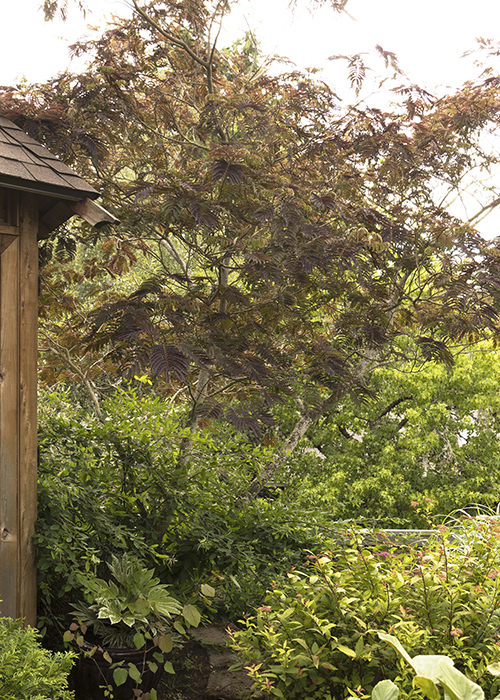A garden should consist of many varied plants, but let's take some time to focus on one of the most important aspects of any outdoor space—trees. Small trees, in particular, are perfect for fulfilling many versatile roles in a well-designed garden.
The best small trees will bring height, color, and texture in addition to holding their own in winter and complementing the rest of your garden in other seasons. Small trees are the ultimate vertical accents in the garden, acting like punctuation points in a landscape. They're also perfect for framing your home, a view, or a garden bed.
(Above) Forest Pansy Redbud is a fantastic example of a small tree that accomplishes a multitude of tasks in the garden—from the seasonal interest of bright spring flowers to the lovely structure that offers a vertical, sculptural accent to any sunny space. Up to 20' tall, 25' wide. Zones 5-9.
Photo by Doreen Wynja
Small Trees as "Anchor Plants"
Considered the "bones" of the garden, anchor plants are generally the first features to be planted in a new garden. However, there are many ways to add small trees to your existing garden that will enhance its structure and work as beautiful solutions with problem areas.
A prominent way to use a small tree in the landscape is as a visual centerpiece that draws attention to a particular area. In this case, it performs the starring role of a focal point—directing the eye to a destination or a place where the eye can rest.
A tree doesn’t have to be large to grab your attention; it just has to be in the right place. Well-placed small trees will transform your garden from being just ho-hum and set it on course to being spectacular.
Get Started With a Stunner
Speaking of attention-grabbing, let's look at a real eye-catcher to illustrate how small trees can work in garden design: Zig Zag Redbud. True to its name, this tree features unique zig-zagged stems and branches. While that alone would catch your eye, it also has bright pink early spring blooms on the bare branches, attractive green heart-shaped leaves, and bright orange fall color.
Get Planting
Ready to skip the rest of class and get planting? Use the design below to create a serene entryway with the Zig Zag® Redbud. You can find more plans like these in our Front Yard Design Guide.

...Still here? Great! Let's dig into some garden design details.
What are "anchor plants?"
A garden should consist of an array of trees, shrubs, grasses, and perennials that maintain the garden’s structure all year long. The plants that fulfill this role are referred to as “anchor plants.” When strategically placed, they give a landscape balance, form, and continuity—they’re the backbone of a garden. Trees are the ultimate "anchor plant" because they provide larger structure and form (not to mention shade, habitat, and clean air).
What is a Small Tree?
Typically, a "small tree" is defined as growing to maturity at twelve to thirty feet tall (the Black Tulip™ Magolia pictured above reaches up to 20' tall). However, you have many options for small and dwarf trees to fit your tighter spaces. Remember that small trees have great appeal in larger gardens, too.
Small trees are advantageous choices not only because their scale suits smaller spaces but also because they pose less threat to structures in severe weather. In larger gardens, small trees are great understory plants to larger trees, creating visually interesting layers of tree canopy.
When does a tree reach maturity?
That depends on the tree. Like children, some of them grow up faster than others. Remember to factor in the tree’s estimated mature size when choosing your small tree.
Pro Tip: To determine how far to plant a tree from structures, divide the anticipated mature spread of the tree in half and plant it that distance away from your home or any other structure. For example, if your chosen tree reaches twenty feet wide, plant it at least ten feet away from a structure.
You will find that My PlantFinder simplifies the selection process with its filter criteria, allowing you to find the right plant for the right place easily.
Small trees have big potential
Using small trees as anchors in the garden will, more than any other plant, add significant environmental value to your landscape.
Even the smallest trees will absorb carbon dioxide, release oxygen in exchange, and reduce home energy costs by providing shade in summer and windbreak in winter. Their roots absorb stormwater, reducing water runoff into waterways, which helps to improve water quality and reduces flooding. They also provide wildlife habitat and food, ensuring a healthier ecosystem.
How to Build Garden Beds Around Small Trees
When you need an anchor plant to build a bed around, consider trees that will complement and not overwhelm the surrounding plants.
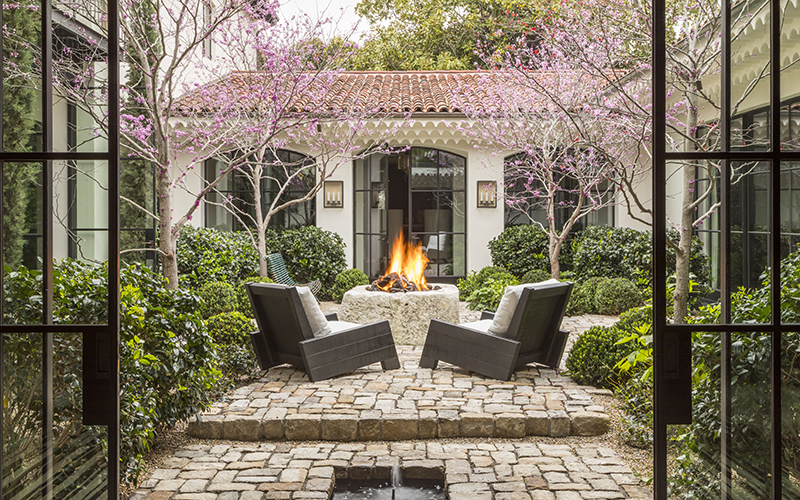
Creating Balance
The balance and symmetry of the redbud trees in formal garden beds are pleasing to the eye. The openness of the tree in spring, with its rosy pink flowers on bare branches, is especially pretty. But even in full leaf, the form of the trees allows for good visibility of the neighboring plants. Redbuds offer four seasons of interest, which works well in the courtyard, where they are viewed up close year-round.
Photo © Lisa Romerein/OTTO , design by Scott Shrader (see more about this space here)
Creating Contrast and Adding Texture
Here, the fullness of the Grace Smoke Tree provides a captivating contrast in summer with its mixed textures of feathery plumes and large, rounded leaves. Its cascading form draws the eye downward to the low-growing perennials in the bed. It anchors the composition with its lushness and unique, eye-catching textures.
Using Repetition
Color repetition is another anchor technique that helps unify a garden. In the following photo, the dramatic foliage of Golden Hinoki False Cypress paired with Golden Sweet Flag draws the eye, but the symmetry of the planting is simultaneously soothing.
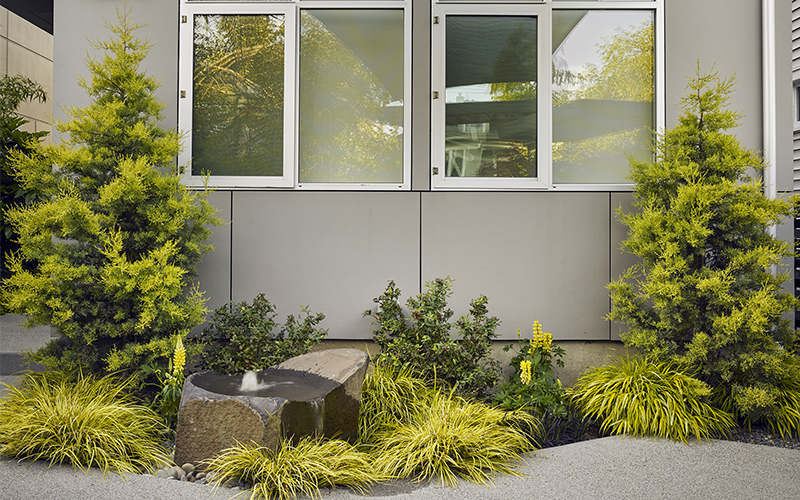
Fine-textured plants like the feathery sprays of Golden Hinoki Cypress create the illusion of more space, which is a great way to expand a small garden visually. Conversely, bold or course-textured plants create visual weight and impact, making a larger garden seem smaller.
Cold Zone Pro Tip: Plant deciduous trees that lose their leaves in winter to allow sunshine to warm the house.
Photo by Ken Gutmaker, Design by Lisa Port of Banyon Tree Design (see more about this space here).
More Eye-Catching Small Trees
Flame Thrower®
Redbud
Light-pink spring flowers are followed by an ever-changing display of colorful foliage that continues all the way to fall. New foliage emerges burgundy, fades to yellow, and matures to green. Branches display all the colors at once for a stunning effect. Partial to full sun. Up to 20' tall, 15' wide. Zones 5-9.
Royal Purple
Smoke Tree
Dramatic, long-lasting, pinkish purple, smoke-like airy seed clusters backed by reddish-purple foliage create a prized small tree or large accent shrub. Foliage holds its color all summer, then turns scarlet red in autumn. Full sun. Up to 15' tall, 12' wide. Zones 4-10.
Crimson Queen
Japanese Maple
This dwarf tree boasts a graceful, weeping form. Its leaves maintain their crimson hue throughout the summer and turn vibrant scarlet come autumn. Sun-tolerant in cooler regions, where sunlight intensifies the foliage color. Site in a bright dappled shade setting elsewhere. Perfect for a large container! Partial to full sun. Up to 10' tall and wide. Zones 5-8.
Small Evergreen Trees Offer Year-Round Impact
Evergreens are good anchor plants since they retain their foliage year-round, provide a strong visual impact, and add to the backbone or structure of the garden. As a landscape designer, I recommend a high ratio of evergreens over deciduous plants because they add interest in winter, privacy, sound barriers, and windbreaks year-round. And who doesn’t like seeing foliage all year long?
It is essential to consider structure and year-round interest when planning your garden. Evergreen trees will provide other plants with a solid foundation.
The Colorado Blue Spruce is a great example. It's prized for its bright blue needles and deer resistance, but usually, it requires lots of room to grow to its potential. But not JeanGenie™ Colorado Spruce. JeanGenie™ is a smaller variety, only growing 10-15’ tall and 6-8’ wide. Its blue color induces a sense of calm while being attractive in the winter landscape.
When not taking center stage, evergreen shrubs can be used as living walls to separate one area from another or as a backdrop in a border bed. A border bed should have a solid background (it can also be a fence or a house, but we’re talking plants here). Border beds are viewed from only one side, which makes the plant you choose as a backdrop an influential choice.
Many juniper varieties fulfill that need in the garden. Consider the Green Columnar Juniper pictured here, growing just 15’ tall and 5’ wide; it is a stately specimen with an attractive upright, pyramidal form. This evergreen can be strategically placed at corners of your home or another structure to anchor the architecture to the garden.
Wichita Blue Juniper is a handsome North American native evergreen that retains silvery blue foliage year-round. Planted in full sun, it makes an excellent deer-resistant background hedge. Growing just 10-15’ tall and 4-6’ wide, It will anchor your summer-blooming plants while providing structure in winter.
Not all evergreens are conifers
Evergreen trees also include non-coniferous classics like the Southern Magnolia (Little Gem is a great dwarf option), olive (try Little Ollie® for a dwarf tree), and Strawberry Tree. Learn more about small trees for small spaces that grow in Zones 7-11 here.
Pro Tip for Cold Zones: Plant evergreen trees on the north and northwest to block winter wind, but not where they will block winter sunshine.
Favorite Small Evergreen Trees
JeanGenie™ Colorado
Blue Spruce
The beauty of a classic Colorado blue spruce on a slower-growing plant, perfect for smaller landscapes. A handsome pyramidal form with a denser growth habit and brighter blue needles. Use as an evergreen windbreak or screen, or as a specimen plant in large landscapes. Part to full sun. Up to 15' tall, 8' wide. Zones 2-8.
Little Gem Dwarf
Southern Magnolia
A dwarf southern magnolia with smaller dark green foliage and a very compact narrow form. The large, glossy, evergreen leaves have rusty-brown undersides. Very attractive, large, white, fragrant blooms. Full sun. Up to 25' tall, 15' wide. Zones 7-9.
Icee Blue®
Yellow-Wood
The first Podocarpus tree with distinctive blue foliage! New growth emerges lime-gray-blue then matures to a cool gray-blue-green. One of the most beautiful and decorative pyramidal conifers for the South. An excellent specimen, lawn, or screen tree. Up to 25' tall and wide. Zones 9-11.
Small Trees as Problem Solvers
Selecting plants that can thrive in the growing conditions of your garden and locating them for visual appeal and health of the tree is the principle of “right plant, right place." Applying this principle when planning your garden will add more livability and value to your home.
While we are naturally drawn to trees for their aesthetic appeal, let’s consider their more practical function—as problem solvers. The problem that needs to be solved in your landscape will inform your design solution and plant selection. The following examples may help you navigate a problem area in your landscape.
You want to add curb appeal:
Frame the walkway or the entry door with a symmetrical planting of matching small trees that won’t overwhelm the scale of your home. Or, add a single small tree to the corner of your foundation garden bed to add height and visual interest.
Line the path to your home with an allée of trees planted along the driveway or entrance path. This classic planting technique adds grace and drama to your home.
You need privacy:
Plant a mixed understory of small trees or large shrubs with horizontal and vertical layering in staggered rows to fill in the gaps. Choose upright plants with colorful foliage or interesting textures to create accents. A shallow understory layer may only have one or two layers of plants, while a deep bed will have many more layers. Remember to take into consideration how the accent trees are viewed from afar.
You'd like to block an eyesore from view:
Plants and hardscape features like containers and structures work as anchors in the landscape. Place a single large-scale container among plantings to draw the eye away or use planted containers as focal points. This technique works well in island beds because they are not set against a backdrop. The anchor may be in the center or slightly offset, creating an asymmetrical effect. Below are two attractive selections to use in this way.
Velvet Viking™Japanese Maple is an excellent container specimen with its low, spreading branches on a beautifully mounded, weeping dwarf form. It has a lacy, delicate appearance yet is exceptionally tough and cold-tolerant. Its short stature, growing just 3’ tall and 5’ wide, makes for an excellent low anchor point in a garden bed.
Photo by Doreen Wynja
The alluring weeping dark purple foliage of Chocolate Fountain™ Mimosa Tree belies its rugged nature. The summer blooms are silky puffs of pink that seem to float over the fern-like foliage. Growing just 15-20’ tall and 15’ wide in the landscape, the drought-tolerant tree will be smaller when grown in a container for which it is well-adapted. It is an elegant accent in a container or as a focal point tree in a garden bed. The dramatic dark foliage is the perfect backdrop against which you can plant vibrant colors and create a focal point in your garden.
Photo by Doreen Wynja
One who plants a tree plants hope~Lucy Larcom
My hope is that I have caught your attention with a fresh way to view your garden and that you’ll find that planting more trees will bring you happiness. Happy gardening!
Learn More About Gardening with Trees
- Sign up for our Grow Beautifully newsletter to get more design inspiration and garden tips. As well as how-tos and first access to exclusive plants.
- Best Small Trees for Fall Color
- Best Problem-Solving Small Trees (Zones 7-11)
- Best Problem-Solving Small Trees (Zones 4-8)
- Best Spring-Blooming Trees: Favorites for white, pink, and purple flowers
- Small Trees for Big Impact
- How to Select the Right Japanese Maple
- 10 Striking Dwarf Japanese Maples
- 10 Facts Every Japanese Maple Lover Needs to Know
- Unusual Types of Japanese Maples
- The Best Dwarf Conifers Offer Big Solutions




